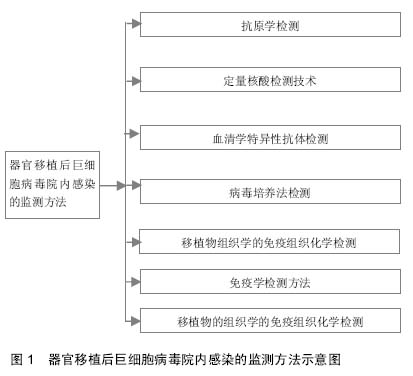| [1] Craig JM, Macauley JC, Weller TH, et al. Isolation of intranuclear inclusion producing agents from infants with illnesses resembling cytomegalic inclusion disease. Proc Soc Exp Biol Med. 1957:94(1):4-12.
[2] Ariza-Heredia EJ, Nesher L, Chemaly RF. Cytomegalovirus diseases after hematopoietic stem cell transplantation: a mini-review. Cancer Lett. 2014;342(1):1-8.
[3] Minton K. Viral immunity: How CMV bypasses immune memory. Nat Rev Immunol. 2010;10(5):288.
[4] Bate SL, Dollard SC, Cannon MJ. Cytomegalovirus seroprevalence in the United States: the national health and nutrition examination surveys 1988–2004. Clin Infect. Dis. 2010;50(11):1439-1447.
[5] 黄云帆,陈虹,王旭,等.肝移植后巨细胞病毒感染:对排斥反应与移植物的影响[J].中国组织工程研究,2014,18(27):443-4428.
[6] Boeckh M. Complications, Diagnosis, Management, and Prevention of CMV Infections: Current and Future. Hematology Am Soc Hematol Educ Program. 2011; 305-309.
[7] Green ML, Leisenring W, Stachel D, et al. Efficacy of a viral load-based, risk-adapted, preemptive treatment strategy for prevention of cytomegalovirus disease after hematopoietic cell transplantation. Biol Blood Marrow Transpl. 2012;18(11): 1687-1699.
[8] Lisboa LF, Asberg A, Kumar D, et al. The clinical utility of whole blood versus plasma cytomegalovirus viral load assays for monitoring therapeutic response. Transplantation. 2011; 91(2):231-236.
[9] Plosa EJ, Esbenshade JC, Fuller MP, et al. Cytomegalovirus Infection. Pediatr Rev. 2012,33(4):156-163.
[10] 杨菁,王东.人巨细胞病毒被膜磷蛋白pp65的检测及其在肾移植受者CMV病诊断中的临床应用[J].南方医科大学学报, 2008, 28(2): 263-265.
[11] Martin JM, Danziger-Isakov LA. Danziger-Isakov2 Cytomegalovirus risk, prevention, and management in pediatric solid organ transplantation. Pediatr Transpl. 2011; 15(3):229-236.
[12] Roman A, Manito N, Campistol JM, et al. The impact of the prevention strategies on the indirect effects of CMV infection in solid organ transplant recipients. Transplant Rev (Orlando). 2014;28:84-89.
[13] 何小舟,许贤林,叶青,等.肾移植后RT-PCR动态检测巨细胞病毒尿的临床意义[J].苏州大学学报(医学版),2007,7(4):591-594.
[14] Hanfler J, Kreuzer KA, Laurisch K, et al. Quantitation of cytomegalovirus (hCMV) DNA and beta-actin DNA by duplex realtime fluorescence PCR in solid organ (liver)transplant recipients. Med Microbiol Inununol. 2003;192(4):197-204.
[15] 周文强,石炳毅,蔡明,等.肾移植后受者人巨细胞病毒巢式PCR检测[J].中国实验诊断学杂志,2007,11(5):628-629.
[16] Stoeher M, Berg J. Normailized quantification of human cytomegalovious DNA by competitive real-time PCR on the Light Cyrcler instrument. J Clin Microbilol. 2002;40(12): 4547-4553.
[17] Mewara A, Mishra B, Ratho RK, et al. Comparison of PCRs for IE-1 and gB genes with ELISA of IgM antibodies for diagnosis of human cytomegalovirus disease. Acta Virol. 2010;54(4):315-316.
[18] Ahmadinejad Z, Ardalan FA, Razzaqi M, et al. QuantiFERON-TB Gold in Tube test for diagnosis of latent tuberculosis (TB) in solid organ transplant candidates: a single-center study in an area endemic for TB. Transpl Infect Dis. 2013;15(1):90-95.
[19] Longworth SA, Vinnard C, Lee I, et al. Risk factors for nontuberculous mycobacterial infections in solid organ transplant recipients: a case-control study. Transpl Infect Dis. 2014;16:76-83.
[20] Giulieri S, Manuel O. QuantiFERON(R)-CMV assay for the assessment of cytomegalovirus cell-mediated immunity. Expert Rev Mol Diagn. 2011;11(1):17-25.
[21] Wiita AP, Roubinian N, Khan Y, et al. Cytomegalovirus disease and infection in lung transplant recipients in the setting of planned indefinite valganciclovir prophylaxis. Transpl Infect Dis. 2012;14(3):248-258.
[22] Ren Y, Ding Q, Zhang X. Ficolins and infectious diseases. Virol Sin. 2014;29(1):25-32.
[23] Wadhawan M, Gupta S, Goyal N, et al. Cytomegalovirus infection: its incidence and management in cytomegalovirus-seropositive living related liver transplant recipients: a single-center experience. Liver Transpl. 2012; 18(12):1448-1455.
[24] Kotton CN. CMV: prevention, diagnosis and therapy. Am J Transpl. 2013;13(s3):24-40.
[25] Hoyo I, Sanclemente G, Cervera C, et al. Opportunistic pulmonary infections in solid organ transplant recipients. Transplant Proc. 2012;44(9):2673-2675.
[26] Blyth E, Clancy L, Simms R, et al. Donor-derived CMVspecific T cells reduce the requirement for CMV-directed pharmacotherapy after allogeneic stem cell transplantation. Blood. 2013;121(18):3745-3758.
[27] Witzke O, Hauser IA, Bartels M, et al. Valganciclovir prophylaxis versus preemptive therapy in cytomegalovirus- positive renal allograft recipients: 1-year results of a randomized clinical trial. Transplantation. 2012;93(1):61-68.
[28] Avkan-Oguz V, Ozkardesler S, Unek T, et al. Risk factors for early bacterial infections in liver transplantation. Transpl Proc. 2013;45(7):993-997.
[29] Emery VC, Asher K, Sanjuan CJ. Importance of the cytomegalovirus seropositive recipient as a contributor to disease burden after solid organ transplantation. J Clin Virol. 2012;54(2):125-129.
[30] Abate D, Saldan A, Mengoli C, et al. Comparison of CMV ELISPOT and CMV QuantiferonTM interferon-c releasing assays in assessing risk of CMV infection in kidney transplant Recipients. J Clin Microbiol. 2013;51(8):2501-2507.
[31] 唐志琴,王玉亮,江雁,等.肝肾移植后巨细胞病毒感染者T细胞表面CD38的动态变化[J].中华微生物学和免疫学杂志, 2006, 26(3): 252-254.
[32] Ticha O, Stouracova M, Kuman M, et al. Monitoring of CD38high expression in peripheral blood CD8+ lymphocytes in patients after kidney transplantation as a marker of cytomegalovirus infection. Transpl Immunol. 2010;24(1): 50-56.
[33] Bestard O, Lucia M, Crespo E, et al. Pretransplant immediately early-1-specific T cell responses provide protection for CMV infection after kidney transplantation. Am J Transplant. 2013;13:1793-1805.
[34] 肖漓,石炳毅,高钰,等.HLA-G与肾移植后巨细胞病毒活动性感染的相关性研究[J].中华器官移植杂志,2011,32(9):534-538.
[35] Clari MA, Munoz-Cobo B, Solano C, et al. Performance of the QuantiFERON-cytomegalovirus (CMV) assay for detection and estimation of the magnitude and functionality of the CMV-specific gamma interferon-producing CD8(+) T-cell response in allogeneic stem cell transplant recipients. Clin Vaccine Immunol. 2012;19(5):791-796. |

